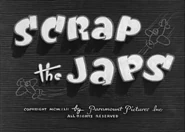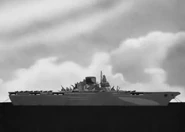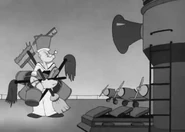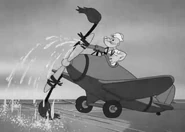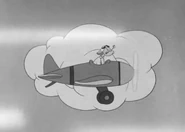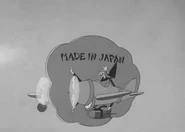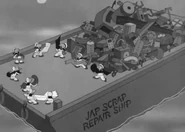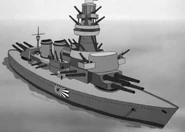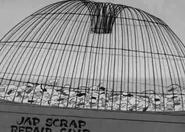| Scrap the Japs | |
| Number 112 | |
| Guide | |
| previous A Hull of a Mess |
next Me Musical Nephews |
Scrap the Japs is Popeye's one hundred twelfth theatrical short from Famous Studios and was released on November 20, 1942.
Plot[]
Popeye is a scout pilot on an aircraft carrier in WWII. He is assigned to swab the decks, polish all brass, clean cannons, wash propellers, scrape and oil engines and many other duties for his negligence in jumping out an airplane without a parachute. He makes short work of his duties by using good old American ingenuity. He swabs the deck by tying mops to a plane's props as he goes around the ship. He combines many colors of paint together in one can to paint the camouflage on the ship. He also takes a shortcut by sweeping the dirt under one of the gun turrets.
His duties are cut short when all scout pilots are called to man planes with full equipment and take off after an enemy plane attacks the ship. Popeye flies his into some storm clouds and is fired at by the same Japanese pilot hidden behind a fake cloud. Popeye suspects something fishy, discovers the deception and shoots down the plane. However, Popeye falls out of his own plane and goes down as well. This time he has his parachute, but it is filled with his dirty laundry and his pots and pans. His emergency chute is an old boot, but it makes an adequate substitute.
Both Popeye and the enemy pilot land on the Jap Scrap Repair Ship. The pilot's plane is quickly repaired, but Popeye destroys it again when he lands on top of it. Popeye commandeers the repair ship as a Japanese battleship approaches and fires two torpedoes at him. He reins in the ship like a wild horse and uses the torpedoes to maneuver around and attack the battleship. Popeye catapults himself over the bow and fights off all the attacking Japanese. He then runs to the stern and fashions a giant can key to open the top deck of the battleship like a big can of sardines. The main deck of the ship collapses and he captures all the enemy sailors. Popeye tows the captured Japanese on the repair ship with his recovered plane.
Trivia[]
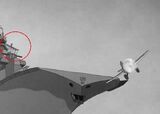
As the planes take off of the flight deck, there appears to be a mast rigged with a sail behind the primary. Ironically enough, the Essex-class aircraft carrier USS Intrepid (CV-11) fashioned a jury-rigged sail out of scrap canvas and hatch covers, which allowed the ship to return to Pearl Harbor after a Japanese torpedo bomber scored a hit near her stern. The torpedo struck 15 feet below the waterline on the night of February 17, 1944, jamming the ship's rudder to port. At first, the captain was able to counteract the jammed rudder by running the port side screw at high speed while idling the starboard screw for two days until high winds overpowered the improvised steering. The fabricated sail was used after that, which allowed her to arrive at Pearl Harbor on February 24, 1944. Perhaps the crew were Popeye the Sailor fans and used the animator's idea to return them safely home.
This short contains many scenes depicting symbols of patriotism and inspiration that helped drive US soldiers throughout World War II.
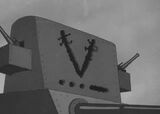
After Popeye defeats the Japanese on his initial assault of the battleship, the sailors are thrown through the Conning-tower to forma a "V" and the Morse code for the letter "V" under it, dot-dot-dot-dash. It was the signal for resistance all over the world after the symbol became popular from Winston Churchill's famous "V-for-victory" sign.
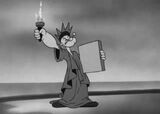
Another symbol of patriotism is shown after Popeye captures a Japanese Navy WWII repair ship that takes the form of a garbage barge. He eats his spinach to fight the sailors off single handed, but when he throws the empty can into the ocean they abandon the vessel to salvage the scrap metal. Popeye instead uses the mighty spinach power to represent the Statue of Liberty complete with robe, tablet and torch.
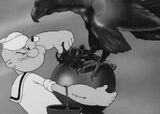
Another symbol is seen after Popeye finishes all his duties. He climbs up a mast to feed a few worms to some baby birds that have made their nest at the top. The nest is built under a statue of an American bald eagle. This bird was chosen as the national emblem of the United States of America on June 20, 1782.
Gallery[]
External links[]
- Scrap the Japs at the Internet Movie Database
- Popeye the Sailor Man 113 – Scrap the Japs video at Dailymotion
Last Updated: 5/24/2023


